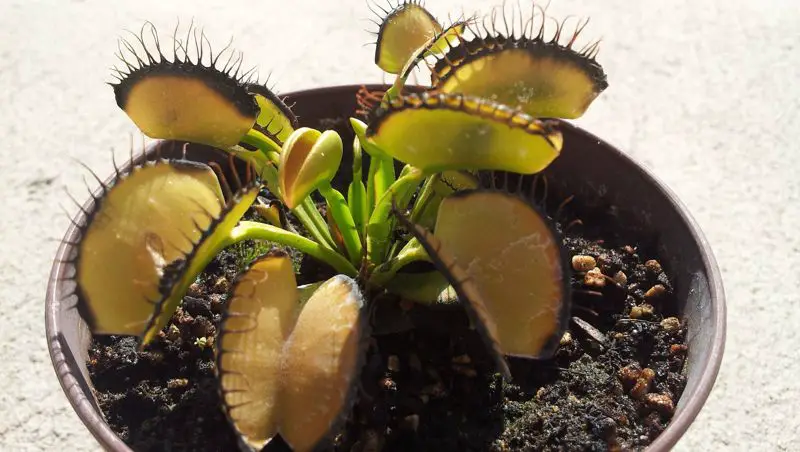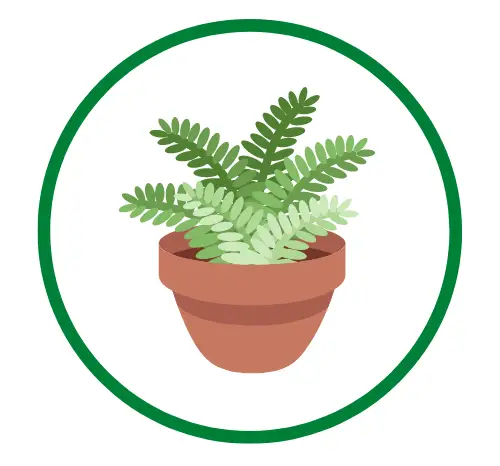Why Venus fly trap turning black?
Don’t freak out if you give your Venus flytrap a tasty meal only to watch it turning black and die over the next few days. For a variety of reasons, traps can turning black, and the majority don’t harm the plant. Below, I’ve provided a list of the top 5 causes. When venus flytraps are malnourished, especially in the winter when they are in their winter dormancy, it is common for them to turning black.
The plant starts to deteriorate during winter dormancy as a result of nutrient deficiencies. The Venus flytrap frequently experiences nutrient deficiencies, which results in its leaves turning black and beginning to wither. This article describes how the Venus flytrap’s natural tendency toturning black. Read on to find out why venus fly traps turning black and how to handle flytrap leaves that have turned black.

Inappropriate food 
Inadequate Diet
Due to their particular carnivorous diets, venus flytraps will blacken around inedible items or food that does not fit their requirements. Venus flytraps need a particular diet that includes insects like flies, spiders, and beetles. They will turn black on the leaves if they are fed the incorrect diet, especially in the vicinity of inedible objects.
Overfeeding
Overfeeding your Venus flytrap can result in nutrient overdose, which can turn the traps of your plant black. As problematic as nutrient deficiency is nutrient overdose. Consequently, you should treat it seriously. A venus flytrap should only eat one or two insects every two weeks at most. If you notice blackening after feeding your Venus flytraps, reduce their feeding schedule.
Unsuitable food
Don’t give your plant any sausage, chocolate, or other foods that it wouldn’t naturally catch. This will undoubtedly lead to the trap rotting. Remove the dead leaf with a scissors and begin feeding your plant correctly.
Don’t feed your plant bugs anything that is bigger than a third of the size of the trap if you are feeding them. The trap might not be able to fully seal if the insect is too large or if one of its legs or antennae sticks out, which will result in the leaf dying once more. Just cut it out and wait for new growth to take its place.
Adjust Diet
Analyze the diet of your Venus flytrap and make the necessary adjustments. You should change your Venus flytrap’s diet if you don’t feed it one bug every one to two weeks. Additionally, you might need to change the diet you give your Venus flytrap. Beetles, spiders, flies, and other insects are the only types of animals that Venus flytraps will eat. If you are giving them any other food, you should modify it to suit their requirements.
Stress from poor growing conditions

- Do you provide your plants with enough water? High concentrations of dissolved minerals in both tap water and bottled water frequently cause your plant’s roots to burn. To test your water, purchase a TDS reader.
- Is there enough light for your plant? Venus flytraps prefer full sun, so growing them in a dark location will result in more black spots on the traps.
- Are you utilizing the right soil? Venus flytraps require nutrient-deficient soil, just like the majority of carnivorous plants. Anything with fertilizer, including regular potting compost, will harm your plant. Use pure sphagnum moss, either live or dried, which you can purchase from The Shop, or peat moss combined with lime-free horticultural sand and/or perlite (the traditional carnivorous plant soil, available from specialty nurseries).
Inadequate Soil
Venus flytraps thrive in mineral-free, nutrient-deficient soil. If you plant a Venus flytrap in nutrient-rich soil, it will probably die, starting with its leaves turning black. Additionally, the soil you use should have superb drainage. Never use fertilizer on your Venus flytrap because the nutrients will turn the leaves black.
Overfeeding

Energy is needed to digest an insect and close a trap. It’s likely that some of the leaves will turn black and die if you feed every single trap on your plant, or worse, if you trigger the traps for fun without feeding them.
Avoid panicking; this probably won’t be fatal. Simply put, your plant is concentrating its energy on growing new leaves. Wait a month or two before feeding, and in the future, try to feed no more than one trap per week (especially on small plants). Put your plant outside on a sunny day if you want to give it a chance to try and gather some food naturally.
I always share the following tips with new growers: feeding your plants should be the very last thing on your list! If you want to successfully grow carnivorous plants, you should prioritize other matters before you start growing carnivorous plants.
If you want to successfully grow carnivorous plants, you should prioritize other matters before you start growing carnivorous plants.
Inadequate Soil
Venus flytraps thrive in mineral-free, nutrient-deficient soil. If you plant a Venus flytrap in nutrient-rich soil, it will probably die, starting with its leaves turning black. Additionally, the soil you use should have superb drainage. Never use fertilizer on your Venus flytrap because the nutrients will turn the leaves black.
Change Soil
You can restore the Venus flytrap’s leaves to their original color by altering the soil to meet the plant’s needs. Use aerated, nutrient-deficient soil for your Venus flytrap to effectively drain water and grow. Soil is available from any gardening supply store. The ideal soil for your Venus flytrap can be suggested by gardening experts.
Winter dormancy

Venus flytraps, like many other temperate plants, need a long period of cold winter dormancy to survive. It’s typical for some traps to turn black and die as your plant enters its winter resting phase as the days grow shorter and the temperatures drop. This time frame typically occurs in the northern hemisphere between November and February.
It’s likely that your flytrap plant is just beginning its dormancy if its leaves have begun to fall off in the late autumn (and if you’ve met all of its other growing requirements!). You can safely remove any dead leaves and slightly reduce watering until spring because this is completely normal. After that, as the days grow longer and the temperature rises, your plant will start making new traps.
Wait Out the Season
There isn’t much you can do to fix your Venus flytrap if the changing seasons are to blame for it turning black. Waiting for winter to end is the only way to assist a plant’s black leaves that are experiencing winter dormancy. Your plant should acquire color once the season changes.
Natural lifecycle

If the oldest traps in the rosette are the ones that are darkening, or if the trap in question has already caught and digested a number of insects, then this is probably a normal phase of the trap’s life cycle. If your plant is still producing new growth to replace the old traps, then there is no need for concern.
Turning black Venus Fly Traps Be Cut Off?
Turning black leaves and traps on your Venus flytraps should be cut off or pruned because doing so will stop the plant’s dead parts from absorbing nutrients.
Without pruning, your Venus flytrap will waste nutrients by distributing them unevenly among its living and dead leaves. Other leaves start to turn black when plants distribute nutrients unevenly, wasting them.
Leaf pruning promotes uniform nutrient distribution. Following a feeding, your plant will evenly distribute the food among the active leaves rather than supplying nutrients to the dormant ones. The Venus flytrap’s vibrant green and red color are a result of the plants’ ability to thrive due to the even distribution of nutrients. The plant’s stunning flower also develops thanks to this nutrient distribution.
Pruning is a simple and quick process that can aid in the better growth of your plant. Cut your leaves below the black area with a pair of gardening shears or a pair of precise scissors. The plant can regenerate if the cut is made directly above the living area. Your Venus flytrap is dead if it is completely black.

FAQ
How do I keep my Venus flytrap from turning black?
Venus fly traps can develop blackened leaves when grown in regular potting soil or amended soil. To ensure a Venus flytrap’s healthy growth, choose pure peat moss or long-fiber sphagnum moss and make sure it is aerated with silica sand or perlite.
What does it mean when Venus flytrap Turns black?
It takes a lot of energy to close a trap and digest the food inside. If you close too many at once, the plant uses all of its reserves and the traps begin to blacken. Wait until the traps are fully open and feed just one or two a week.
How do I know if my Venus flytrap is dying?
A dying Venus flytrap succumbs relatively quickly. The leaves die completely, and all that remains of the plant is something all mushy and gooey. See what a dying Venus flytrap looks like by freezing a lettuce leaf and thawing it on your counter.
Should I cut off black Venus flytraps?
Use scissors to remove dead flowers, or pitcher plants and Venus flytraps, cut off the dead traps if they go black – this often happens in autumn and winter.
How often should a Venus flytrap be watered?
The most of of fly traps only require watering every 10 to 14 days. The soil ought to get much drier (though never fully dry). While the rest of the soil should be dry, the area immediately around the base and roots should be slightly damp. As you would at any other time, water the plant, making sure to water it completely.

